You're welcome! I would really prefer to titrate my borates like you. When you get your Boric acid you could make a standard Borate solution by adding 1.13 grams of Boric acid to 1 gallon of DI water...this would give you a 50 ppm standard to test against. If your results are anywhere near 50 ppm I would buy the reagents and dump the Lamotte strips.
New borate drop test at piscines-apollo vs. test strip
- Thread starter rcy
- Start date
You are using an out of date browser. It may not display this or other websites correctly.
You should upgrade or use an alternative browser.
You should upgrade or use an alternative browser.
I've used the original version of this test and found it to be quite accurate. It sounds like the Amazon source for the indicator dye is a bit weak, but that shouldn't throw off the test results.
The key to the test is to note that in the first part of the test it usually just takes one drop to change color and you need to remember what that color looks like because you want to titrate to that same color in the second part of the test. The color transition is clear but not extremely sharp so you'll get more accuracy remembering the color and titrating to that same spot. At least it will reduce the error by about one drop.
The key to the test is to note that in the first part of the test it usually just takes one drop to change color and you need to remember what that color looks like because you want to titrate to that same color in the second part of the test. The color transition is clear but not extremely sharp so you'll get more accuracy remembering the color and titrating to that same spot. At least it will reduce the error by about one drop.
- May 23, 2015
- 24,472
- Pool Size
- 16000
- Surface
- Plaster
- Chlorine
- Salt Water Generator
- SWG Type
- Pentair Intellichlor IC-60
I've used the original version of this test and found it to be quite accurate. It sounds like the Amazon source for the indicator dye is a bit weak, but that shouldn't throw off the test results.
The key to the test is to note that in the first part of the test it usually just takes one drop to change color and you need to remember what that color looks like because you want to titrate to that same color in the second part of the test. The color transition is clear but not extremely sharp so you'll get more accuracy remembering the color and titrating to that same spot. At least it will reduce the error by about one drop.
Ah, ok, that is key then! When I did the test, adding one drop of the R-0010 definitely sent the color from yellow to blue and the second drop made it more blue. The mannitol turns it back to yellow and then the final drop(s) of R-0010 take you back to blue. So, if I was supposed to look for the same color blue (light blue not darker blue), then my drop count should have been 6 drops not 7 drops.
That would mean my borate level is 6 drops X 7.9ppm/drop = 47.4ppm.
Any chance the TFP Admins would allow you to write up a Sticky for this test procedure? I hate having to scroll through this thread to find the details. I know it's still a Work-In-Progess, but having it as a sticky would be helpful.
- May 23, 2015
- 24,472
- Pool Size
- 16000
- Surface
- Plaster
- Chlorine
- Salt Water Generator
- SWG Type
- Pentair Intellichlor IC-60
Yev
0
Any chance the TFP Admins would allow you to write up a Sticky for this test procedure? I hate having to scroll through this thread to find the details. I know it's still a Work-In-Progess, but having it as a sticky would be helpful.
JoyfulNoise, along those lines, here is what I think is the up to date full version of what you are doing, with a couple of questions that I would love to have answered at the end. maybe you or Chemgeek can read through and tidy up for me.
Chemicals Needed
Taylor R-0007 - Part of TF-100
Taylor R-0009 - Part of TF-100 TA Test
Taylor R-0010 - Part of TF-100
Bromothymol Blue (BTB) - From Amazon
Mannitol - From Amazon
Test Procedure
1.) Collect a 25ml sample of pool water .
2.) Add 2 drops of R-0007 to neutralize the chlorine
3.) Add 5 drops of R-0009
4.) Add 6 drops of BTB until the water turns yellow.
5.) Add 2 drops of R-0010 until the water just turns blue.
6.) Add 1 level spoonful (1/8 teaspoon) of Mannitol. If the water has boron/borates, then the sample will turn yellow.
7.) Add R-0010 drops until the water just turns blue. Record how many rops of R-0010 are used.
8.) Calculate ppm boron/borates by multiplying the number of drops of R-0010 used only in step 7 by 7.9 for total ppm
Alternative Test Method
1.) Collect either 25ml, 44ml, or 50ml
8.) Calculate ppm boron/borates by using these formulas
For 25ml sample, each drop of R-0010 used only in step 7 equals 7.9ppm
For 44ml sample, each drop of R-0010 used only in step 7 equals 4.5ppm
For 50ml sample, each drop of R-0010 used only in step 7 equals 4.0ppm
Questions About Test
1.) The level spoonful that was mentioned, is that the scoop that comes with the TF-100 kit for the FAS-DPD test, or is this a new measuring device that was added to the kit?
2.) Is the use of Boron and Borates synonomous?
3.) For the Mannitol powder, would it be possible to buy this one which seems to be the same, just 4 ounces rather than a pound, so it is a bit cheaper.
4.) For the BTB, there is this option that is 0.1% rather than the option which is 0.04%, so perhaps this is better. The downside is that I am not sure this type of bottle dropper will work well or not.
- May 23, 2015
- 24,472
- Pool Size
- 16000
- Surface
- Plaster
- Chlorine
- Salt Water Generator
- SWG Type
- Pentair Intellichlor IC-60
JoyfulNoise, along those lines, here is what I think is the up to date full version of what you are doing, with a couple of questions that I would love to have answered at the end. maybe you or Chemgeek can read through and tidy up for me.
Chemicals Needed
Taylor R-0007 - Part of TF-100
Taylor R-0009 - Part of TF-100 TA Test
Taylor R-0010 - Part of TF-100
Bromothymol Blue (BTB) - From Amazon
Mannitol - From Amazon
Test Procedure
1.) Collect a 25ml sample of pool water .
2.) Add 2 drops of R-0007 to neutralize the chlorine
3.) Add 5 drops of R-0009
4.) Add 6 drops of BTB until the water turns yellow.
5.) Add 2 drops of R-0010 until the water just turns blue.
6.) Add 1 level spoonful (1/8 teaspoon) of Mannitol. If the water has boron/borates, then the sample will turn yellow.
7.) Add R-0010 drops until the water just turns blue. Record how many rops of R-0010 are used.
8.) Calculate ppm boron/borates by multiplying the number of drops of R-0010 used only in step 7 by 7.9 for total ppm
Alternative Test Method
1.) Collect either 25ml, 44ml, or 50ml
8.) Calculate ppm boron/borates by using these formulas
For 25ml sample, each drop of R-0010 used only in step 7 equals 7.9ppm
For 44ml sample, each drop of R-0010 used only in step 7 equals 4.5ppm
For 50ml sample, each drop of R-0010 used only in step 7 equals 4.0ppm
Questions About Test
1.) The level spoonful that was mentioned, is that the scoop that comes with the TF-100 kit for the FAS-DPD test, or is this a new measuring device that was added to the kit?
2.) Is the use of Boron and Borates synonomous?
3.) For the Mannitol powder, would it be possible to buy this one which seems to be the same, just 4 ounces rather than a pound, so it is a bit cheaper.
4.) For the BTB, there is this option that is 0.1% rather than the option which is 0.04%, so perhaps this is better. The downside is that I am not sure this type of bottle dropper will work well or not.
Questions About Test
1.) The level spoonful that was mentioned, is that the scoop that comes with the TF-100 kit for the FAS-DPD test, or is this a new measuring device that was added to the kit?
I purchased a stainless steel, 1/8 teaspoon measure. Mannitol-D powder is basically a sugar alcohol and a food additive. I felt the high grade SS measure would be perfectly fine for it. The amount of mannitol powder added is not critical because you are just trying to saturate the solution with mannitol so it can react with all of the borate ions in solutions. I would not use the plastic scoop from the DPD powder reagent so as to not run into any cross-contamination issues.
2.) Is the use of Boron and Borates synonomous?
Well, no. Boron is the solid metallic form of the boron atom. Borates are the oxyanion of boron & oxygen that can adopt polymeric like structures, with orthoborate BO3[3-] being the simplest form. The test measures the borate ion concentration.
3.) For the Mannitol powder, would it be possible to buy this one which seems to be the same, just 4 ounces rather than a pound, so it is a bit cheaper.
Perhaps, as long as it is 100% ACS reagent grade mannitol-D powder.
4.) For the BTB, there is this option that is 0.1% rather than the option which is 0.04%, so perhaps this is better. The downside is that I am not sure this type of bottle dropper will work well or not.
Go for it! I bought what was listed in this thread. If I had to do it over again, I would try to find a stronger concentration. Again, the amount of BTB indicator dye is only important in so far as you can see the color develop. The amount of indicator, like the amount of mannitol powder, isn't really critical as long as it is doing it's job.
Also, I would change Step #5 to read -
"5.) Add enough drops of R-0010 until the water just turns blue. Typically one (1) drop is enough."
Yev
0
2.) Is the use of Boron and Borates synonomous?
Well, no. Boron is the solid metallic form of the boron atom. Borates are the oxyanion of boron & oxygen that can adopt polymeric like structures, with orthoborate BO3[3-] being the simplest form. The test measures the borate ion concentration.
OK, let me ask this in another way for someone who is not a chemist, and is chemistry dumb. I added boric acid to my pool, and targeted what I thought was 50ppm borates based upon the Pool Math calculator. Your test seems to give you ppm Boron. so for pool care purposed, this test tests teh same PPM as what pool math calculator refers to?
- May 23, 2015
- 24,472
- Pool Size
- 16000
- Surface
- Plaster
- Chlorine
- Salt Water Generator
- SWG Type
- Pentair Intellichlor IC-60
OK, let me ask this in another way for someone who is not a chemist, and is chemistry dumb. I added boric acid to my pool, and targeted what I thought was 50ppm borates based upon the Pool Math calculator. Your test seems to give you ppm Boron. so for pool care purposed, this test tests teh same PPM as what pool math calculator refers to?
Simple answer - YES
2.) Is the use of Boron and Borates synonomous?
Well, no. Boron is the solid metallic form of the boron atom. Borates are the oxyanion of boron & oxygen that can adopt polymeric like structures, with orthoborate BO3[3-] being the simplest form. The test measures the borate ion concentration.
The test (using its conversion factors) measures in units of ppm Boron, same as what PoolMath uses and is the standard used for measuring boron compounds.
- May 23, 2015
- 24,472
- Pool Size
- 16000
- Surface
- Plaster
- Chlorine
- Salt Water Generator
- SWG Type
- Pentair Intellichlor IC-60
The test (using its conversion factors) measures in units of ppm Boron, same as what PoolMath uses and is the standard used for measuring boron compounds.
Ok, understood. When I read the question I was thinking more along the lines of what the actual chemical reaction is which, if I'm not mistaken, is the borate anion reacting with the mannitol to form a complex which has a lower pK than the borate anion by itself in solution.
I realize this is probably a "Deep End" discussion, but do you happen to know of a reference where this test or the reaction between mannitol and the borate ion is explained?
As I describe in this post earlier in this thread, it is boric acid that reacts with mannitol to form a more acidic compound and that is what drops the pH. If one were to start with borate ion, the pH would not drop. The first part of the test first adds acid and then titrates to get from yellow to blue so gets at the bromothymol blue transition point (between pH 6.0 and 7.6). At normal pool pH of 7.5, 97.71% is boric acid with 2.22% borate ion and 0.07% as a calcium borate ion pair CaB(OH)4+. You then add mannitol and this reacts with borate ion so this lowers the pH as boric acid equilibrates to produce more borate ion. With sufficiently excess mannitol concentrations the reaction essentially goes to completion with all of the boric acid converted to a mannitol-borate ion complex.
By starting with the "just blue" transition point of bromothymol blue, one is at a sufficiently low pH such that boric acid is the predomominant species (remember that even at pH 7.5 it's 98% boric acid) so formation of mannitol-borate creates a one-to-one creation of hydrogen ions to be titrated and correspond to the borate concentration (again converted into ppm Boron units). This paper describes what occurs in detail. At excess mannitol concentrations, what they call the BD2 complex is the dominant species and reactions I, II, and III (but not IV) are what occur in sequence. Boric acid is in equilibrium with borate ion where a pair of hydroxyls react with half of a mannitol (with its own pair of hydroxyls) to form an ion complex. The other pair of hydroxyls on the boron then react with another half of a mannitol.
By starting with the "just blue" transition point of bromothymol blue, one is at a sufficiently low pH such that boric acid is the predomominant species (remember that even at pH 7.5 it's 98% boric acid) so formation of mannitol-borate creates a one-to-one creation of hydrogen ions to be titrated and correspond to the borate concentration (again converted into ppm Boron units). This paper describes what occurs in detail. At excess mannitol concentrations, what they call the BD2 complex is the dominant species and reactions I, II, and III (but not IV) are what occur in sequence. Boric acid is in equilibrium with borate ion where a pair of hydroxyls react with half of a mannitol (with its own pair of hydroxyls) to form an ion complex. The other pair of hydroxyls on the boron then react with another half of a mannitol.
- May 23, 2015
- 24,472
- Pool Size
- 16000
- Surface
- Plaster
- Chlorine
- Salt Water Generator
- SWG Type
- Pentair Intellichlor IC-60
So here are my most current test results using both a 25mL water sample and then a 44mL sample.
Water parameters -
Tests performed at 2pm which is very bright, hot sun.
FC = 3.4ppm (bumping this up to 5ppm as soon as I'm done)
CC <0.2ppm
TA = 70ppm
pH = 7.6
CYA = 70ppm
CH = 750ppm
Salt = 4000ppm
Temp = 88F
Test #1:
44mL water sample (4.5ppm/drop)
8 drops needed to convert straw yellow to faint blue
BA = 36ppm
Test #2:
25mL water sample (7.9ppm/drop)
5 drops needed to convert straw yellow to faint blue
BA = 39.5ppm
Borate testing used two (2) drops of R-0007 to dechlorinate samples. Also, I modified the test and added enough BTB indicator dye to produce a visibly strong, straw-yellow color. Since I was working in outdoor lighting, 5 drops of the BTB indicator I have is not noticeably yellow enough. Also, it only took 1 drop of the R-0010 calcium buffer solution to make the first transition from yellow to faint blue. I made a mental note of the light blue color but I can't help but think that the strength of the R-0010 titrant is causing some overshoot past the BTB transition point.
So here's a wish list of changes to the test -
1. Stronger, more intense BTB indicator that forms droplets more easily;
2. A weaker calcium buffer solution such that the test sensitivity at 25mL would drop to 2.5ppm/drop (if at all possible).
The calcium buffer solution is fairly strong so the initial change from yellow to light blue happens with just one drop. Therefore there's no way to know how far over the transition point you have crossed. A weaker buffer solution would allow one to titrate better. As well, modifying the titrant to optimize the test for the 25mL sample size makes using the SpeedStir, SampleSizer and p/n 9198 test vial easier. The 9198 vial can just barely hold a 44mL water sample.
Water parameters -
Tests performed at 2pm which is very bright, hot sun.
FC = 3.4ppm (bumping this up to 5ppm as soon as I'm done)
CC <0.2ppm
TA = 70ppm
pH = 7.6
CYA = 70ppm
CH = 750ppm
Salt = 4000ppm
Temp = 88F
Test #1:
44mL water sample (4.5ppm/drop)
8 drops needed to convert straw yellow to faint blue
BA = 36ppm
Test #2:
25mL water sample (7.9ppm/drop)
5 drops needed to convert straw yellow to faint blue
BA = 39.5ppm
Borate testing used two (2) drops of R-0007 to dechlorinate samples. Also, I modified the test and added enough BTB indicator dye to produce a visibly strong, straw-yellow color. Since I was working in outdoor lighting, 5 drops of the BTB indicator I have is not noticeably yellow enough. Also, it only took 1 drop of the R-0010 calcium buffer solution to make the first transition from yellow to faint blue. I made a mental note of the light blue color but I can't help but think that the strength of the R-0010 titrant is causing some overshoot past the BTB transition point.
So here's a wish list of changes to the test -
1. Stronger, more intense BTB indicator that forms droplets more easily;
2. A weaker calcium buffer solution such that the test sensitivity at 25mL would drop to 2.5ppm/drop (if at all possible).
The calcium buffer solution is fairly strong so the initial change from yellow to light blue happens with just one drop. Therefore there's no way to know how far over the transition point you have crossed. A weaker buffer solution would allow one to titrate better. As well, modifying the titrant to optimize the test for the 25mL sample size makes using the SpeedStir, SampleSizer and p/n 9198 test vial easier. The 9198 vial can just barely hold a 44mL water sample.
Ordered my BTB/mannitol yesterday! Hope to try to duplicate your efforts this week!
- May 23, 2015
- 24,472
- Pool Size
- 16000
- Surface
- Plaster
- Chlorine
- Salt Water Generator
- SWG Type
- Pentair Intellichlor IC-60
Ordered my BTB/mannitol yesterday! Hope to try to duplicate your efforts this week!
Outdoor lighting helped a lot for me. Also, add as much BTB as you need to develop a well defined, straw yellow color. The BTB dropper bottle is weird and dribbles a lot. It's also a fairly soft squeeze bottle so any pressure makes very random sized droplets. I actually have plastic, 3mL graduated pipettes and I think I would be better off using that to measure out the BTB indicator.
Good luck! I'll be watching this thread for your results.
Sent from my iPhone using Tapatalk
2. A weaker calcium buffer solution such that the test sensitivity at 25mL would drop to 2.5ppm/drop (if at all possible).
The calcium buffer solution is fairly strong so the initial change from yellow to light blue happens with just one drop. Therefore there's no way to know how far over the transition point you have crossed. A weaker buffer solution would allow one to titrate better.
Certainly having a weaker solution for better sensitivity would be nice, but as far as going to blue with just one drop that really isn't a problem since you just have to match that color during the later part of the test. If it's a darker blue, you target a darker blue. It doesn't overshoot to the point where there isn't an additional change with a second drop. Nevertheless, a weaker calcium buffer solution would be useful for finer control. It's still a decent test at 4.5 ppm per drop using 44 ml or 4.0 ppm per drop using 50 ml.
- May 23, 2015
- 24,472
- Pool Size
- 16000
- Surface
- Plaster
- Chlorine
- Salt Water Generator
- SWG Type
- Pentair Intellichlor IC-60
It's still a decent test at 4.5 ppm per drop using 44 ml or 4.0 ppm per drop using 50 ml.
I absolutely agree
- May 23, 2015
- 24,472
- Pool Size
- 16000
- Surface
- Plaster
- Chlorine
- Salt Water Generator
- SWG Type
- Pentair Intellichlor IC-60
Awesome. Can't wait to hear how it goes. I've been searching out pricing on some extra glassware so I can run the test on my SpeedStir with a 50mL water sample. Just need to find the right size flask/beaker to fit on the speed stir. If all else fails, a 50-mL Erlenmeyer flask is pretty cheap and can easily be hand-stirred for testing.
Ok, so I added 3 72 oz boxes of Mule Team 20 (Sodium Tetraborate Decahydrate for the nerds among us) to my 13000 gallon pool. This should bring my Borate level to approximately 14 ppm. So, without further ado, lets get on with some testing:
First collect a 44 ml sample and have the following reagents available:
BTB - Bromothymol Blue Indicator - order from Amazon.
Mannitol - order from Amazon.
R-0007 - Sodium Thiosulfate - comes with the TF-100 kit.
R-0009 - 0.12 Normal Sulfuric Aid - comes with the TF-100 kit.
R-0010 - Weak Sodium Hydroxide Solution - comes with the TF-100 Kit.
Fill the clear sample tube to the bottom of the Part Number on the vial (this will get you right at 44 ml).
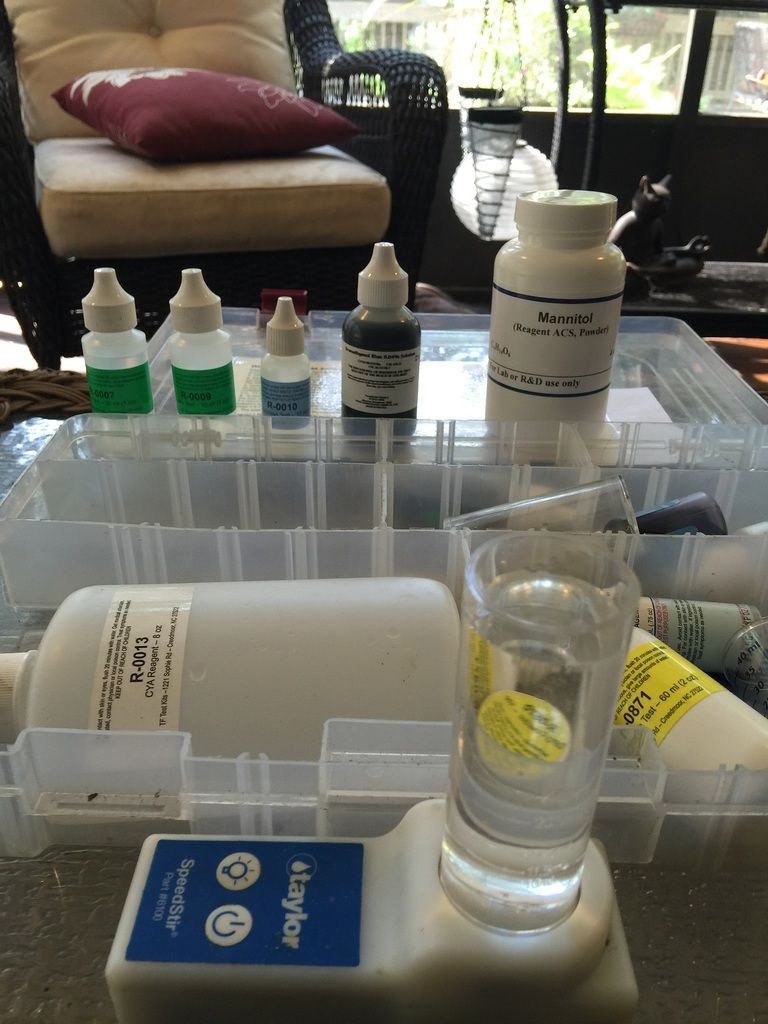
Next, add 2 drops of R-0007 to neutralize the FC
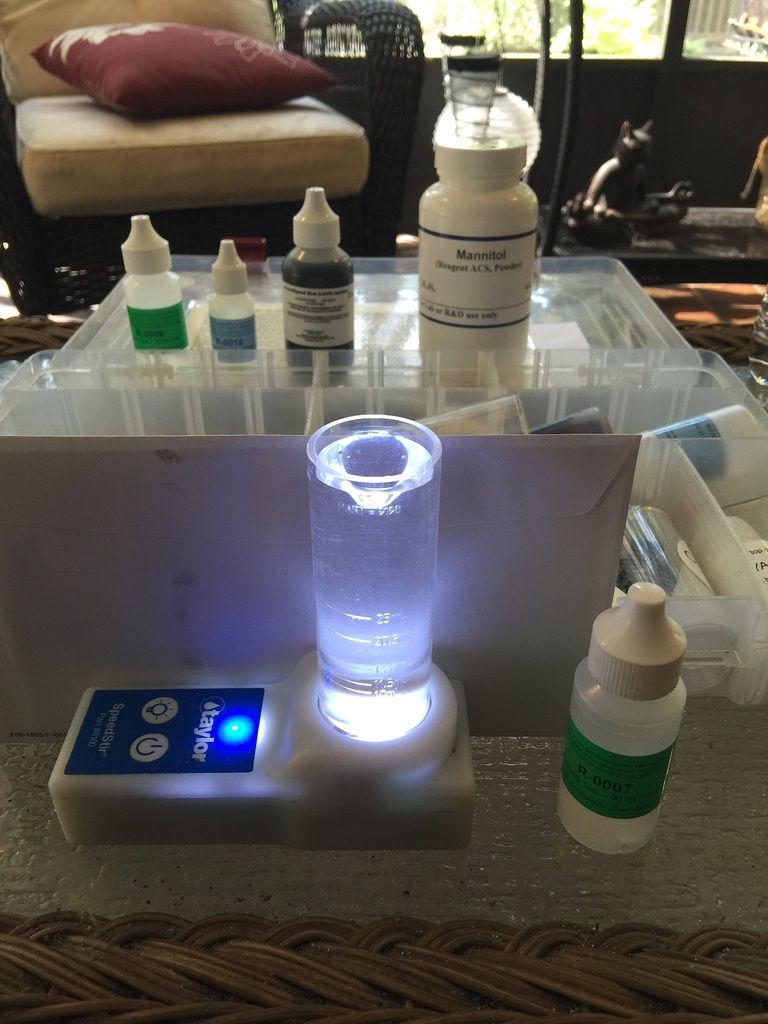
Next, add 5 drops of R-0009
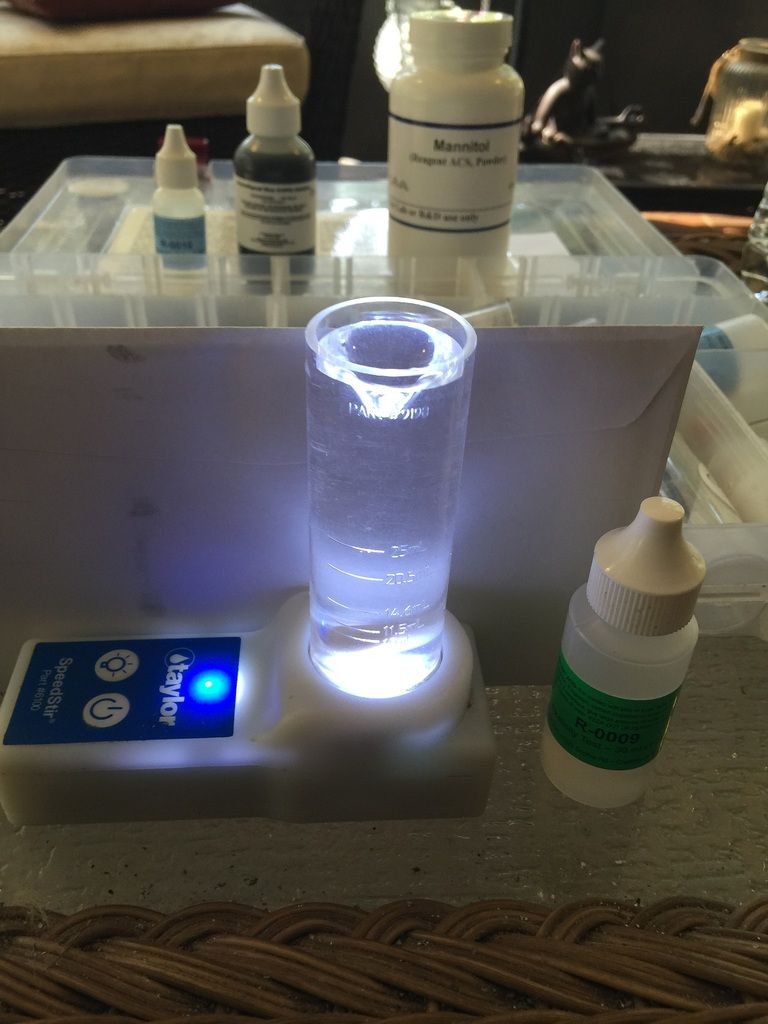
Next add 6 drops of the BTB or until the sample just turns yellow (very light yellow)
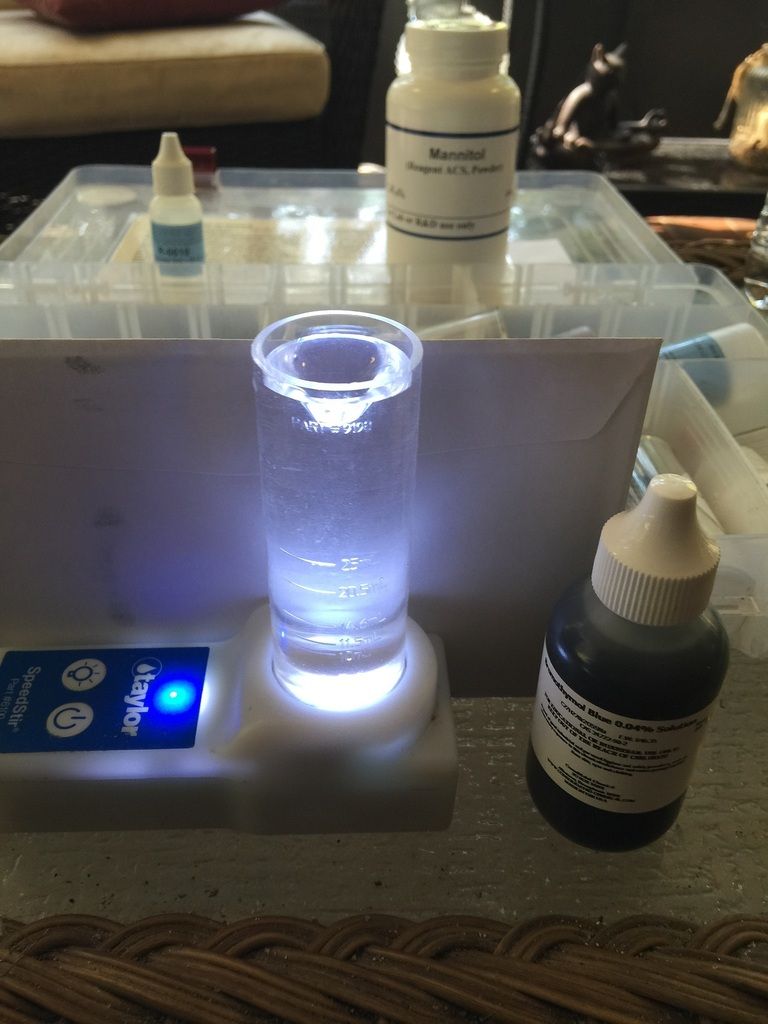
Trust me this is a very light yellow
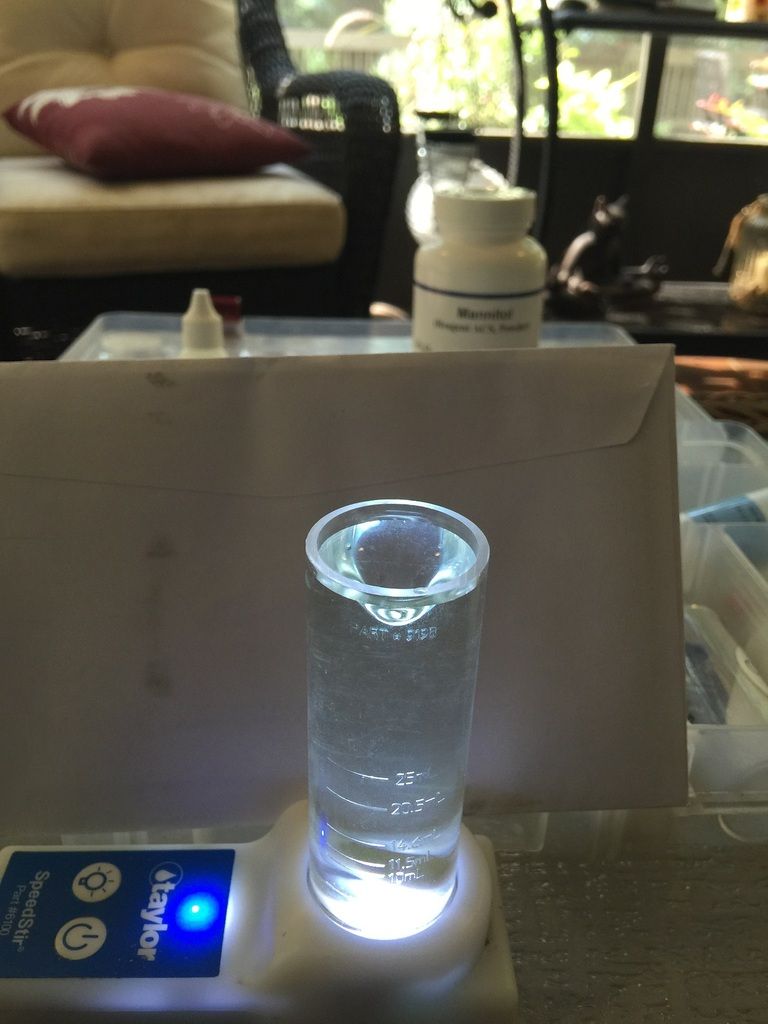
Now add 2 drops of R-0010 until the solution just turns blue...
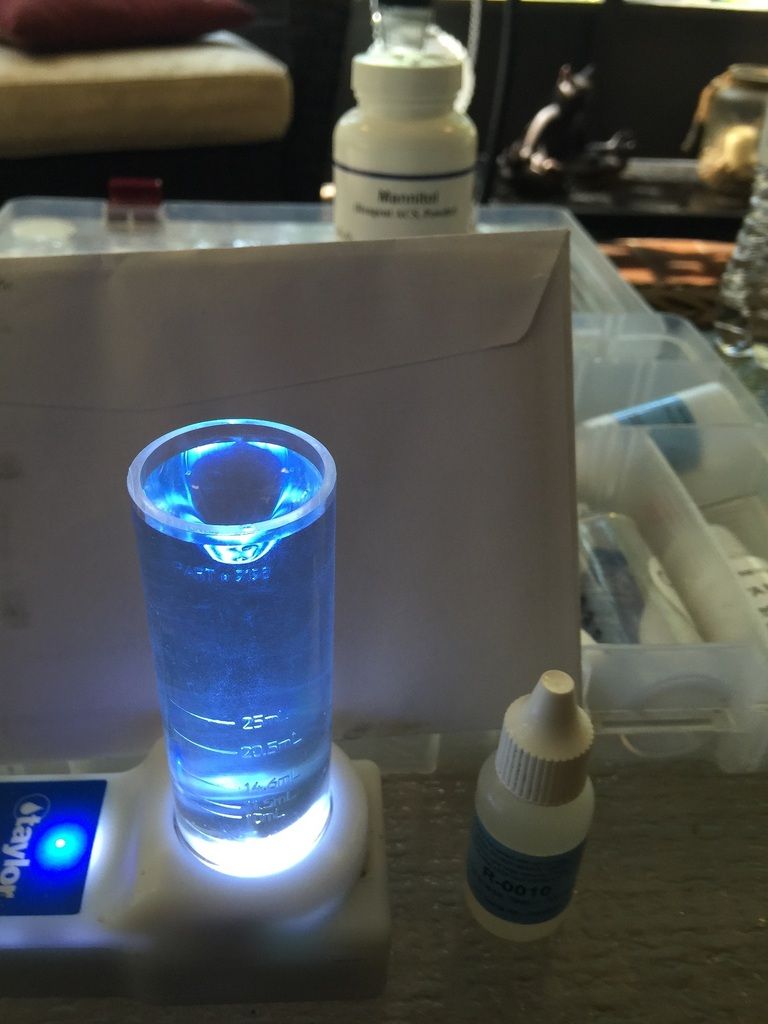
Add 1/8 tsp or 1/2 of a 1/4 tsp of mannitol (I do not have a fancy smancy 1/8 tsp like joyfulnoise)

It will turn yellow if Boron is present...If not, stop testing, as you have no Boron in the water.

Now add R-0010 until the color just turns blue or looks like the color in picture 6...Count the number of drops and multiply by 4.5! Easy peasy...I added 3 drops of R-0010 which gives me a Borate level of 13.5!
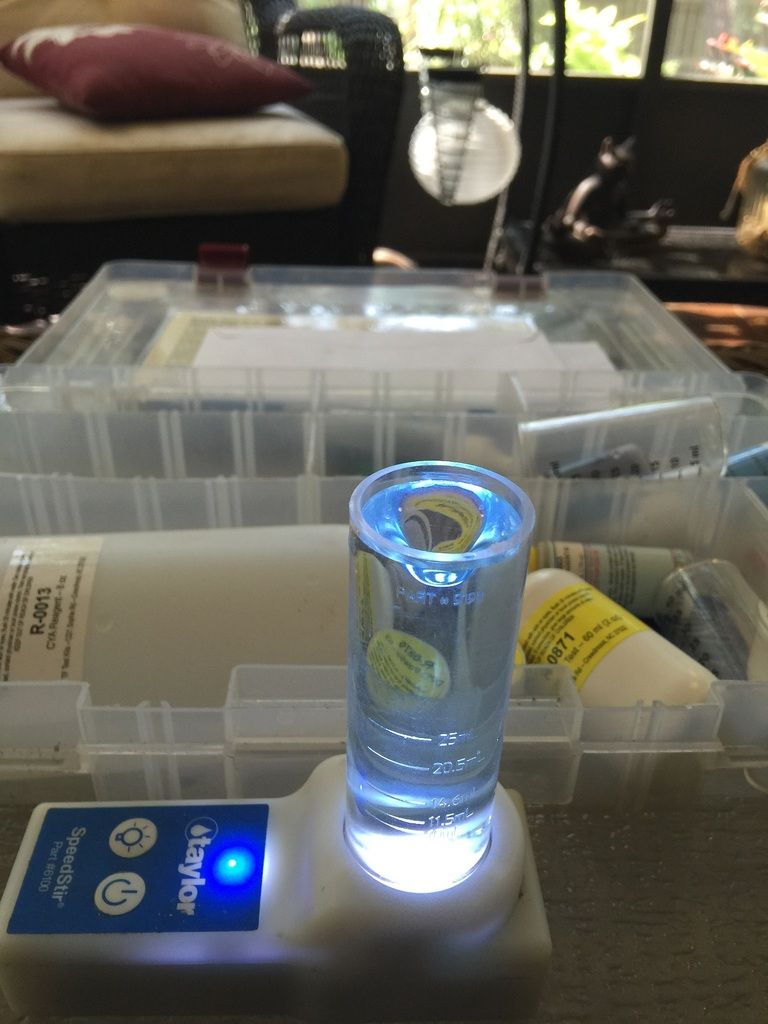
14 ppm was my target and 13.5 was my result...I'll take 0.5 ppm any day of the week! This test will be extremely difficult without a Speedstir. Thanks to everyone in this thread for helping!
First collect a 44 ml sample and have the following reagents available:
BTB - Bromothymol Blue Indicator - order from Amazon.
Mannitol - order from Amazon.
R-0007 - Sodium Thiosulfate - comes with the TF-100 kit.
R-0009 - 0.12 Normal Sulfuric Aid - comes with the TF-100 kit.
R-0010 - Weak Sodium Hydroxide Solution - comes with the TF-100 Kit.
Fill the clear sample tube to the bottom of the Part Number on the vial (this will get you right at 44 ml).

Next, add 2 drops of R-0007 to neutralize the FC

Next, add 5 drops of R-0009

Next add 6 drops of the BTB or until the sample just turns yellow (very light yellow)

Trust me this is a very light yellow

Now add 2 drops of R-0010 until the solution just turns blue...

Add 1/8 tsp or 1/2 of a 1/4 tsp of mannitol (I do not have a fancy smancy 1/8 tsp like joyfulnoise)

It will turn yellow if Boron is present...If not, stop testing, as you have no Boron in the water.

Now add R-0010 until the color just turns blue or looks like the color in picture 6...Count the number of drops and multiply by 4.5! Easy peasy...I added 3 drops of R-0010 which gives me a Borate level of 13.5!

14 ppm was my target and 13.5 was my result...I'll take 0.5 ppm any day of the week! This test will be extremely difficult without a Speedstir. Thanks to everyone in this thread for helping!
- May 23, 2015
- 24,472
- Pool Size
- 16000
- Surface
- Plaster
- Chlorine
- Salt Water Generator
- SWG Type
- Pentair Intellichlor IC-60
Nice work!!
I plan on adding 8lbs of boric acid to my pool (after I backwash the filter) and then test again.
As I said, if I find a good glass cylinder that works with the SpeedStir and is > 50mL, I'll let you know.
Sent from my iPhone using Tapatalk
I plan on adding 8lbs of boric acid to my pool (after I backwash the filter) and then test again.
As I said, if I find a good glass cylinder that works with the SpeedStir and is > 50mL, I'll let you know.
Sent from my iPhone using Tapatalk

